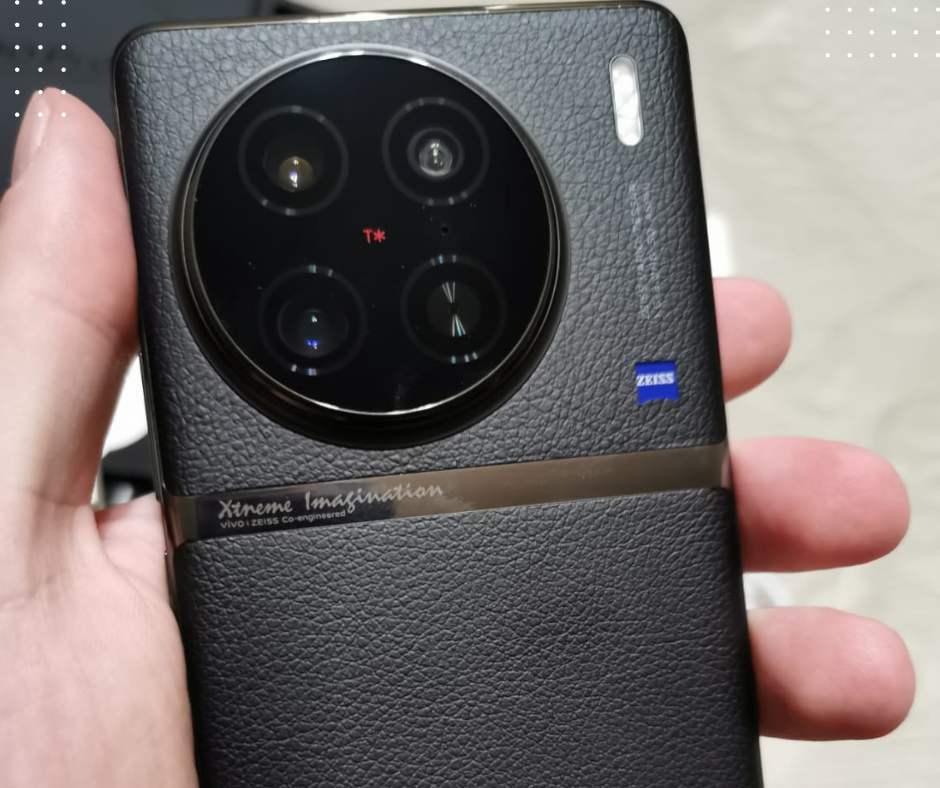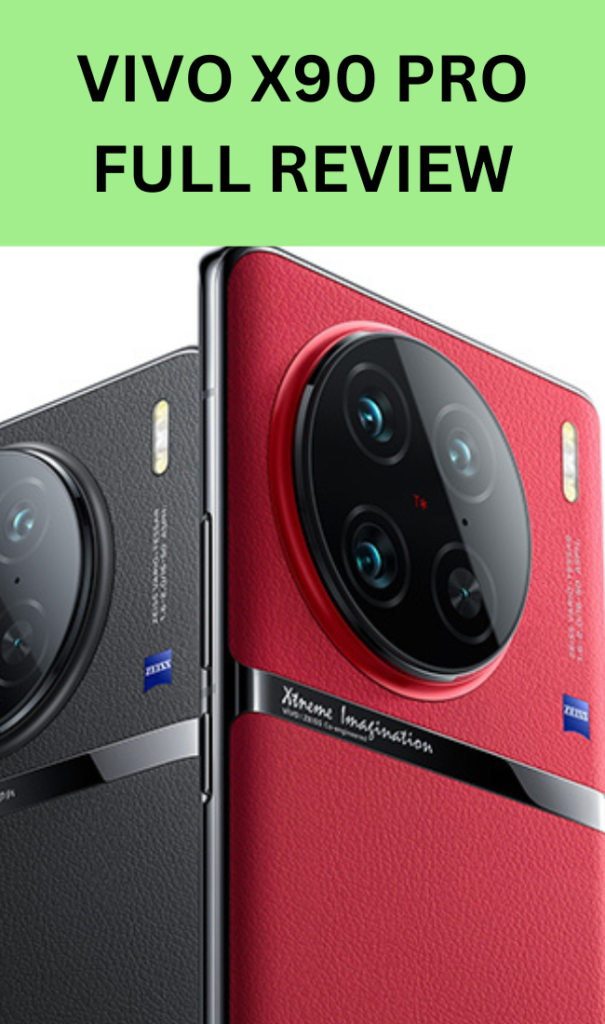VIVO X90 PRO FULL REVIEW
Introducing Vivo’s latest camera-centric flagship, the Vivo X90 Pro. With its distinctive circular glass panel on the back and sleek vegan leather design, this phone resembles a camera in appearance. But how does it perform, and is it the best camera phone of 2023? Let’s take a closer look at the Vivo X90 Pro review.
The X90 Pro is the top-tier model of Vivo’s new lineup, available outside of China. Boasting a one-inch type sensor for its main camera, it shares this feature with the recent Xiaomi 12s Ultra. Additionally, it features a cutting-edge MediaTek chipset, lightning-fast wired and wireless charging, and a high-resolution AMOLED display.
VIVO X90 PRO DESIGN
In terms of design, the X90 Pro represents an evolution of last year’s X80 Pro. Vivo has fully embraced the camera aesthetic, with the new grippy vegan leather finish on the back being a standout feature. For the global version, the only color option available is black. Stay tuned for our full review to see how this device performs in real-world testing.
The Vivo X90 Pro’s back panel features a thin aluminum frame that curves seamlessly into it. The round camera bump has been enlarged and now stands alone without a glass square. Additionally, there is a glossy etched metal band below the camera that runs from one side of the frame to the other, giving it a stylish look. If you’re someone who likes logos and branding on your devices, the Vivo X90 Pro won’t disappoint.
Waterproofing isn’t always a feature found in flagship phones, but the X90 Pro delivers with its IP68 rating against water and dust on the front.
The device boasts a curved 6.8-inch AMOLED display with 1260 by 2800 resolution and a 120 Hz refresh rate. Although the resolution isn’t as high as the QHD panel seen in the previous year’s model, it still offers sharper visuals than the average phone at 453 PPI. The X90 Pro also supports 10-bit color depth and HDR 10 plus, with color accuracy being excellent depending on the color mode selected.
The X90 Pro’s display is plenty bright, with a maximum of 520 nits measured using a manual brightness slider and a boost up to 930 nits in auto mode when in bright conditions. The 120 Hz refresh rate makes on-screen movements smoother, although the switching isn’t as advanced as the ltp03 panel of the previous year’s model. The display can be dialed down to save energy when idling or in certain apps, but only as low as 60 Hz. An optical fingerprint scanner is located beneath the display, which is both fast and reliable.
The Vivo X90 Pro features a pair of stereo speakers that provide excellent loudness and audio quality. The device produces likable mid-tones and well-presented highs, with noticeable bass, making it ideal for music playback. The phone comes with 256 or 512 GB of onboard storage, but it doesn’t support expandable storage via microSD. The global version of the Vivo X90 Pro runs on FunTouch OS 13, which is a highly customized interface built on top of Android 13. It offers full Google support and comes with plenty of custom features.
Within the notification shade, you’ll find simple blue circular buttons rather than Google’s large bubble-style ones. In the dynamic effects submenu, there are numerous customization options for the home screen, lock screen, and animation effects. One nifty feature is the ability to launch an app or perform a specific task by holding down the volume-down key. The device also comes with a dedicated Ultra Game Mode that includes 4D game vibration and an Esports mode. Moreover, you get an in-game overlay that’s similar to what you’d find on dedicated gaming phones.
The Smart Remote app is another unique feature that enables you to control various appliances using the phone’s IR blaster. Additionally, the device comes with The V App Store, an alternative to Google Play.
VIVO X90 PRO CHIPSETS
The Vivo X90 Pro is the first phone to feature the MediaTek Dimensity 9200 chipset, which is top-of-the-line and delivers several advancements in graphics performance, including a hardware-based ray tracing engine.
Furthermore, the Vivo X90 Pro boasts a cutting-edge 6th Gen AI processing unit, which, along with its support for advanced memory technologies like ufs 4.0 and LP DVR 5x Ram, offers exceptional performance. Moreover, it features a third Gen Custom Image processing chip, the Vivo V2, which provides several enhancements over the previous version and promises to deliver the fastest and most efficient camera processing yet from Vivo.
In terms of benchmarks, the Vivo X90 Pro outperforms phones running on demensity 9000 or Snapdragon 8 gen 1, as evidenced by its excellent CPU scores. While it falls slightly behind the Snapdragon 8 Gen 2 in both CPU and GPU tests, it still holds its own.
Additionally, the X90 Pro incorporates a massive heatsink-based cooling system, and we found the thermal management to be adequate during our hour-long CPU and graphic stress tests, although the phone did become uncomfortably hot at times.
The Vivo X90 Pro boasts a slightly larger battery than its predecessor, with a capacity of 4870 milliamp hours compared to 4700. As a result, the X90 Pro’s battery life has improved significantly, scoring a respectable endurance rating of 96 hours in our tests, compared to the X80 Pro’s 79 hours.
The battery is divided into two cells to support the new 120-watt charging, and the adapter is included in the box. We were able to fully charge the X90 Pro in just 24 minutes, which is incredible, and it also supports wireless charging.
VIVO X90 PRO FULL REVIEW OF CAMERAS
Moving on to the X90 Pro’s cameras, the star of the show is undoubtedly the 50-megapixel main camera, which features a massive one-inch type Sony IMX 979 sensor, currently the largest available on a smartphone.
The other cameras in the setup are also impressive, including a 50-megapixel 2x telephoto camera with an extra-wide aperture and a 12-megapixel ultra-wide camera that can also take macro shots. The cameras are Zeiss branded, and the camera software has been developed in collaboration with Zeiss. You can toggle the Zeiss color mode right in the viewfinder.
By default, photos come out at 12.5 megapixels due to pixel binning, and they’re some of the best you can get from a smartphone these days. Although you don’t get the Zeiss color mode by default, the colors are punchy and saturated. The photos are incredibly detailed, with a natural-looking rendition and balanced sharpness, and there’s no noise, with outstanding dynamic range.
With the Zeiss color mode toggled on, the color rendition is true to life, with excellent white balance and spot-on saturation. You can also shoot in a high-res 50-megapixel mode, and the results are equally impressive. Portrait photos from the main camera are also outstanding, with excellent-looking subjects and very proficient separation.
The telephoto cam is primarily designed for portrait mode, although it’s labeled as the “portrait camera”. The quality of portrait shots is equally impressive, with outstanding subject separation.
The telephoto camera uses pixel binning to produce 12.5-megapixel photos, resulting in low noise levels, wide dynamic range, pleasing contrast, and vivid colors. The level of detail is good but not as excellent as the main camera. By switching to the Zeiss mode, the colors look more natural, especially on the telephoto and ultra-wide cameras.
The 12-megapixel ultra-wide camera captures photos with a satisfying level of detail, low noise, and well-aligned corners. The sharpness is acceptable, and the contrast and dynamic range are above average. The colors are as vibrant as on the other cameras, but the Zeiss mode provides a darker exposure and less saturation on the ultra-wide camera.
The ultra-wide camera has autofocus, allowing for macro close-up shots as close as four centimeters. These photos are superb, with detailed, sharp, and colorful images, excellent contrast, and good dynamic range. In low-light conditions, the camera uses multi-image stacking, causing a delay of about one second for each shot to process.
Photos captured with the main camera are exceptional, with excellent resolution, detail, exposure, noise reduction, and color saturation.
The X90 Pro has excellent dynamic range, with rare blown highlights even in challenging lighting conditions. Although there is a night mode available, it doesn’t make a significant difference in most cases since there is already image stacking and processing happening by default.
When using the telephoto cam at night, the X90 Pro produces detailed photos with low noise, good exposure, excellent contrast, and dynamic range, with great colors. The ultra-wide photos taken at night are also solid, with decent detail, good exposure, Punchy colors, and dynamic range.
The dedicated night mode on the ultra-wide cam makes a slight difference, yielding more detail and extra sharpness, as well as brighter skies. The 32-megapixel front-facing cam produces selfies with average detail but good contrast, colors, low noise, and wide dynamic range.
VIDEO PERFORMANCE:
Moving on to video recording with the main cam you can capture video in up to 8K at 24 FPS 8K video is great with plenty of detail Lively colors good contrast and wide dynamic range some of the foliage does look a bit artificial though 4K footage is outstanding in our book.
The Detail level is Flagship worthy the sharpening is on point and the overall processing is natural looking. And like the 8K Clips, you get Vivid colors, likable contrast, and a wide dynamic range. The telephoto camera is zoomed 4K video is solid and gets you good detail levels and balance sharpening, accurate colors no noise, and wide dynamic range.
You can shoot 8K video while zoomed but that would be a digital crop from the main camera. There’s no 8K recording from the ultra-wide cam either, but its 4K videos are impressive even class-leading for this sort of camera. The detail level is superb, and so is everything else you get great sharpness and colors wide dynamic range, and low noise. Electronic stabilization is supported across all cameras and resolutions, and it does a nice job.
The Vivo X90 Pro impresses with its low-light video recording capabilities. Even at night, the 8K videos from the main camera have good detail, sharpness, contrast, dynamic range, colors, and noise levels.
The 4K videos from the main camera are also great, with ample detail, exposure, color saturation, dynamic range, and minimal noise. The main camera’s video night mode is particularly impressive, with outstanding detail, exposure, dynamic range, color accuracy, and no noise, making it one of the best low-light video performers on a phone to date.
The telephoto camera’s 4K videos are also very good, with moderate noise reduction that preserves detail, and excellent exposure, color saturation, and dynamic range. The ultra-wide camera’s 4K low-light videos are decent, with acceptable detail and colors, but a bit dark and noisy, and there’s no night mode support on this camera or the telephoto.
Overall, the Vivo X90 Pro is an excellent flagship phone with outstanding camera performance, good battery life, and fast charging. Its screen refresh rate and zoom level are slightly inferior to some competitors, but these are minor drawbacks. If you’re looking for a feature-packed camera phone at a lower price point than other flagship models, the Vivo X90 Pro is definitely worth considering.











